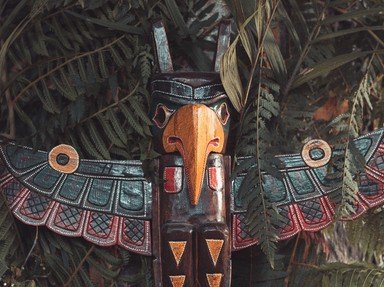Quiz Answer Key and Fun Facts
1. This traditional Navajo home has been built in the past as round or five-sided structures, with the doorway always facing east. What do we call it today?
2. The next traditional lodge was the standard for western semi-nomadic Apaches of the drier Southwest. Generally round and domed, it was composed mostly of larger sticks covered with brush. What is this house called?
3. Heading into the Northeast Woodland culture area, specifically the area between the Great Lakes and the Mississippi, we find Ojibways and Sac and Foxes. What type of domed, bark-covered lodge did these peoples use?
4. Our next lodge is the traditional home of nomadic Plains tribes like the Lakota, Cheyenne, and Comanche. It is cone-shaped and covered by bison hide. Name it.
5. Originally developed in the Southwest from pit houses by the Anasazi, these are still used today by such peoples as the Hopi and Zuni and others. Often having the characteristics of modern apartment buildings, some of these hold an entire village in one large structure of adobe and stone.
6. The Iroquois and other New York and New England area tribes used beads woven into belts to serve as memory and ritual aids, since they had no writing. What term, mistakenly used as a synonym for money, was applied to these beads?
7. Early Native Americans were not the only people to use a tool which helped them impart greater velocity to their spears when throwing them. The Australian aboriginal name for this tool is "woomera." What is the Nahuatl (Aztec) term most often used in America for this spear-throwing tool?
8. In many Native American cultures, tobacco was a sacred plant and the act of sharing it through smoking was a solemn ceremony. Whites often referred to pipes used for smoking as "peace pipes," but by what term, from Norman-French, is more properly used for these native pipes, and more specifically, the red pipestone bowl used to burn the tobacco used in these pipes?
9. Among the Hopi and other pueblo peoples of the US Southwest, dolls are carved which represent various spirits of their traditional religions. What term refers to these dolls?
10. Among the most common Native American artifacts in museums, antique stores, or flea markets, are arrowheads, or "projectile points". What style of projectile point, named for a town in New Mexico near where they were originally found, is generally considered to be the oldest in the United States?
Source: Author
shvdotr
This quiz was reviewed by FunTrivia editor
bloomsby before going online.
Any errors found in FunTrivia content are routinely corrected through our feedback system.

